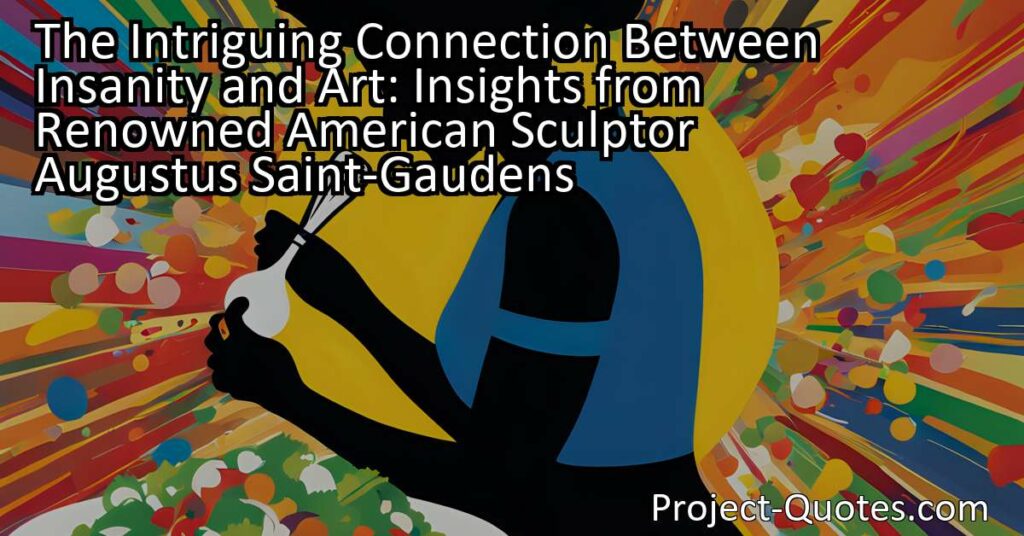What garlic is to salad, insanity is to art.
Augustus Saint-Gaudens
The Intriguing Connection Between Insanity and Art: Insights from Renowned American Sculptor Augustus Saint-Gaudens Explore the fascinating relationship between mental health and artistic expression through the words of famous American sculptor, Augustus Saint-Gaudens. This thought-provoking quote invites us to dive into the world of unconventional thinking and understand how insanity adds vibrancy, originality, and a unique perspective to the world of art. Join us on a journey through history, as we discover the impact of mental health on the artistic process and the transformative power of art itself.
Table of Contents
Meaning of Quote – What garlic is to salad, insanity is to art.
What if I told you that just like garlic adds a unique and powerful flavor to a salad, insanity adds a touch of brilliance and creativity to art? According to the renowned American sculptor Augustus Saint-Gaudens, the connection between insanity and art is nothing short of fascinating. This intriguing quote invites us to explore the intricate relationship between mental health and artistic expression.
In order to truly understand the meaning behind Saint-Gaudens’ words, we must first define what he means by “insanity.” Although the term might carry negative connotations, in this context, it refers to a state of mind that is not ordinary or conventional. It’s a mindset that thinks outside the box, defies societal norms, and dares to wander into uncharted territories of imagination.
Art, in its many forms, serves as a canvas for these unconventional ideas. Just as garlic adds a distinct and pungent flavor to a salad, insanity injects art with vibrancy, originality, and a unique perspective that challenges our conventional understanding of the world. It’s through this lens that we can truly appreciate and value the impact of mental health on the artistic process.
Some of history’s greatest artists and thinkers have been associated with mental health issues. From Vincent van Gogh to Frida Kahlo, their struggles with mental illnesses have become an inseparable part of their artistic legacies. It is often argued that their unique vision and unparalleled creativity are inextricably linked to their experiences of emotional turmoil and psychological struggles.
Insanity, or rather, an unconventional state of mind, allows artists to see beyond the boundaries of reality and embrace the abstract. It fuels their ambition to challenge the status quo, experiment with unconventional techniques, and push artistic boundaries. It grants them the ability to channel their emotions, both positive and negative, into their creations, resulting in works that resonate deeply with those who experience them.
Take, for instance, Vincent van Gogh, one of the most influential and celebrated painters of all time. His iconic paintings, such as “Starry Night” and “Sunflowers,” are beloved for their bold colors, expressive brushstrokes, and immersing emotions. Van Gogh’s struggle with mental illness, particularly depression and psychosis, was well-documented throughout his life. It is believed that his tortured mental state allowed him to see the world in a different light, lending a distinctive and captivating quality to his art.
Similarly, Frida Kahlo, the Mexican artist known for her striking self-portraits, suffered chronic pain and endured numerous physical and emotional traumas. Kahlo’s art not only acted as a form of therapy but also allowed her to communicate her personal struggles, identity, and political beliefs. Her paintings often depict raw emotions, pain, and powerful symbolism, reflecting her inner world and the challenges she faced. It is arguable that Kahlo’s art would not have possessed the same compelling and thought-provoking nature without her experiences of physical and emotional turmoil.
While these examples span the realms of painting, the impact of mental health on art extends to various artistic endeavors. Writers, musicians, dancers, and performers alike have harnessed their unconventional states of being to produce works of profound beauty and significance. The juxtaposition of tragedy and creativity has resulted in timeless poems, haunting melodies, and captivating performances that touch the hearts and souls of audiences worldwide.
The connection between insanity and art goes beyond the individual artist’s experience. Art has the power to resonate deeply with individuals who might themselves be struggling with mental health challenges. It serves as a medium through which they can find solace, relate to the experiences depicted, and even gain insights into their own emotions and struggles. Art can bridge the gap between the artist and the audience, fostering understanding and empathy among people from all walks of life.
In conclusion, Augustus Saint-Gaudens’ quote invites us to embrace the profound relationship between art and insanity. It highlights the unique perspective and creative power that unorthodox states of mind can bring to artistic endeavors. By exploring the experiences of artists throughout history, we come to appreciate the impact of mental health on the artistic process and the enduring and transformative nature of art itself. Just like garlic adds character to a salad, insanity adds depth, intensity, and a touch of brilliance to the world of art.
I hope this quote inspired image brings you hope and peace. Share it with someone who needs it today!


